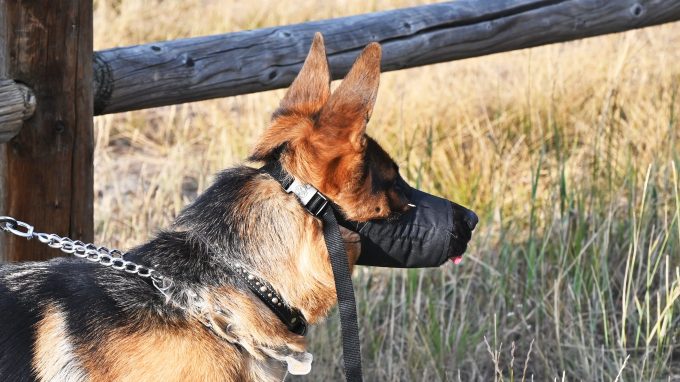
If you’ve been to the park or your local veterinary clinic, you may have seen a dog using a muzzle. There’s a lot of stigma attached to the use of dog muzzles, however, they’re a useful tool that can be beneficial in many situations. Here are some tips on how and when to use a dog muzzle.
Why should you use a dog muzzle?
A dog muzzle is a training tool that can help prevent extra stress for you, your dog, and the people around you. Dog muzzles can help prevent injury to veterinary staff, other animals, and other people. Dog muzzles are also useful tools when working on socialization and training in new situations. It can help a fearful dog feel more calm, and can prevent an injury or bite if a dog gets loose or a situation escalates beyond a safe behavior threshold. Muzzles can also be used to prevent your dog from eating strange things on walks or at the park.
A dog muzzle should not be used unsupervised, for longer periods of time than a few hours, or when alternative methods can be used instead. Since some types of dog muzzles can restrict the ability to pant, eat, drink, and breathe, it’s always best to supervise your dog when using one.
Muzzle training tips and tricks
It’s good to get every dog used to wearing a muzzle — even if your dog isn’t aggressive or doesn’t bite. If you ever end up in an emergency where your dog is severely injured or in pain, a muzzle can safely prevent an accidental bite while receiving care.
To start, find the right muzzle for your needs. Basket muzzles are great for outdoor activities. They allow your dog to pant, breathe, and drink water while preventing a bite. Nylon muzzles are more often used in veterinary settings. They’re used when the jaw needs to be completely secured to prevent a bite, and are harder to remove. The muzzle should fit snugly, but not so tightly that it restricts breathing or blood flow. There are also specially designed muzzles that are usable with shorter-nosed or smush-faced breeds.
Get your dog used to their muzzle before you’re in the situation you need it. Begin by showing your dog the muzzle and offering a treat every time they sniff or show interest. From there, you can open the muzzle and place it in front of your dog’s face. Then, offer a treat through the opening at the end. Once your dog is comfortable, slip the muzzle on for a few seconds, then remove it and reward your dog. It’s best to gradually work up to longer periods of wearing it so your dog isn’t overwhelmed.
Alternatives to dog muzzles
While muzzles are an excellent tool in the right circumstances, there are some times when it’s more appropriate to use an alternative method. For dogs that are recovering from injury or dealing with skin issues, an Elizabethan (cone) collar, donut, or surgery recovery suit can be used. This can prevent licking and chewing without restricting the ability to eat or drink.
For behavioral issues, such as separation anxiety or nervousness around house guests, a crate or gated area of the house is a better alternative. This can keep your dog safely contained and away from harmful or stressful situations. It also gives you the ability to leave them unattended. Be sure to provide food, water, and distraction toys such as a Kong.
It’s always a good idea to speak with a trainer or behaviorist if you have questions about using a muzzle. However, dog muzzles are an excellent training tool that can help your dog in stressful or new situations. If you’re curious about other training tips and tricks, check out our guide on the best training techniques.









